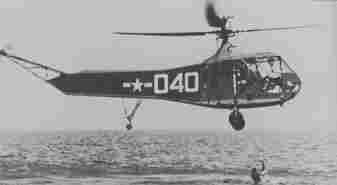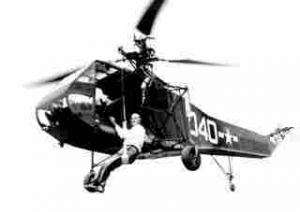Delivered the First Helicopter to the Army Sept. 1944
By AJ Staff Writer

September of 1944 the first helicopter training school was established at Freeman Field. The helicopters used were Sikorsky R – 4Bs and they were flown direct from the Sikorsky plant in Bridgeport, Connecticut, to Freeman. This included a flight over the Allegheny mountains, quite daring for the time. The trip was 725 miles during which several records were set. One included the longest formation flight. The pilots were Major John Sanduski and Lt. Norbert Guttenberger. These men, along with several others from Freeman, received their initial helicopter training at the Sikorsky plant.
Sikorsky began to develop the XR-4 when the U. S. Army Air Corps asked for a more advanced version of his successful VS-300 proof-of-concept helicopter, to compete with the Platt-LePage XR-1. The XR-1 was the first practical helicopter funded by the Air Corps, but technical problems were keeping it grounded. Meanwhile, Sikorsky’s VS-300 was demonstrating performance and ease of control well beyond that of the XR-1. On December 17, 1940, the Air Corps awarded a $50,000 contract to Sikorsky for production of the XR-4. This occurred simultaneously with the ongoing flight-testing of the VS-300. Sikorsky made numerous changes in construction as he optimized the configuration of the VS-300. Originally, Sikorsky designed the XR-4 with two small lifting rotors on the tail-boom, in addition to the anti-torque rotor, to provide lateral and longitudinal control, as he had done in the design of the VS-300. Sikorsky eventually developed a cyclic pitch change mechanism for the VS-300, and was able to eliminate the tail-mounted lifting rotors. This change carried over to the XR-4 under construction, and created a much more capable and efficient machine, as well as giving the world its first look at what would become the conventional configuration for future helicopters.
Steel tubes welded into a box frame and covered with fabric made up the XR-4 fuselage. The two-place side-by-side cockpit contained dual cyclic controls and a single collective pitch control with a twist throttle, mounted between the seats. This configuration proved difficult in practice, since a left seat pilot would have to roll power on in a manner opposite to standard practice, in addition to controlling the cyclic with his left hand. This arrangement, combined with the need for a center instrument console that the pilot could reach with his left hand, began the tradition of the pilot-in-command occupying the right-hand seat in helicopters. This was opposite to the usual arrangement in fixed-wing airplanes where the pilot-in-command occupied the left seat. Instructors in the XR-4 and its subsequent helicopters encountered difficulties training students by sharing the single collective control. This problem was never entirely solved until later training helicopters were equipped with dual collectives. Another difficulty that the Sikorsky team encountered during testing was that the fabric-covered rotors could not withstand the impact of raindrops when they were operating at flight power settings.

Sikorsky’s Stratford, Connecticut, plant built the XR-4 (designated VS-316A, or Vought Sikorsky Model 316A, by the company) in late 1941, and rolled it out, ready to fly, in late December. The helicopter first flew on January 14, 1942, with Sikorsky chief test pilot Les Morris at the controls. AAF officers were immediately impressed with the helicopter’s stability and control. It demonstrated the viability of the helicopter by setting a number of American records. On April 20, 1942, the XR-4 ascended to 1,520 m (5,000 ft). The aircraft was the also the first helicopter outside of Germany to safely travel cross-country. The most significant feat undertaken by Les Morris and the XR-4 was the flight to deliver the machine from the Sikorsky plant to the Army Air Corps test center at Wright Field in Dayton, Ohio. The journey began on May 13, 1942. Since, the aircraft had a maximum speed of seventy miles per hour, and could remain aloft less than two hours, it took Morris sixteen flights between refueling stops to cover the 1,225 km (761 miles) distance. The XR-4 was not cleared to fly at night and the trip required sixteen hours and ten minutes of flight time, spread out over five days.
After careful evaluation, the Air Corps officially accepted the aircraft on May 30, 1942. Colonel Frank Gregory headed the evaluation team. Gregory was the Air Corp’s designated rotorcraft expert and procurement officer. The team completed their trials by January 5, 1943, and pronounced XR-4 suitable for further evaluation and possible mass production. The Air Corps then placed an order for three service demonstration aircraft designated YR-4A. A Warner R-550-1 engine powered this new version. The new motor gave an additional 15 horsepower at cruise and 25 horsepower at takeoff, compared to the XR-4’s original Warner R-500-3 engine. That first engine developed 165 horsepower while cruising and 175 horsepower during takeoff. The U. S. Army Air Forces (AAF) retrofitted the more powerful engine into the XR-4 and designated it the XR-4C. The new engine, like the previous one, frequently overheated due to a lack of cooling air. Even with the increased horsepower, the aircraft could barely lift two people and a load of fuel into a hover when operating on hot days at high-altitude airfields. The tail rotor alone drew 15 horsepower away from power available to the main rotor, but Igor Sikorsky considered this an acceptable sacrifice. A helicopter with two, counter-rotating main rotors could eliminate the need for a tail rotor but this configuration exhibited less precise control than the single-main/single-tail rotor layout Sikorsky favored. Sikorsky tried to squeeze more lifting power from the main rotor by lengthening each rotor blade .3 m (1 ft). The designer also attempted to increase performance by boosting fuel capacity in the YR-4A to 113.7 lit (30 gal), 19 lit (5 gal) more than the XR-4 carried. The interest generated by the trials of the XR-4 and YR-4As prompted the AAF to order thirteen improved YR-4B helicopters with larger cabins with fittings for carrying casualty litters or small bombs.

In May 1943, the XR-4 demonstrated shipboard helicopter operations from the deck of the SS “Bunker Hill.” Sikorsky fitted the XR-4 with pontoon floats and demonstrated takeoffs and landings from the water. Col. Gregory and his team also extensively demonstrated the amphibious XR-4 with much success. The XR-4 and a YR-4A then conducted extensive shipboard operations from the troopship USS “James Parker.” These tests were designed to show that helicopters could protect convoys and conduct anti-submarine patrols. U.S. Navy and Coast Guard officials watched these tests with great interest, then each service ordered three YR-4Bs. The Royal Air Force also ordered seven helicopters. Royal Navy enthusiasm for the helicopter grew after two R-4s deployed aboard the SS “Daghestan.” U. S. Coast Guard, Royal Navy, and Royal Air Force pilots took turns flying the aircraft during a North Atlantic convoy crossing in 1944. Severe weather scrubbed many flights during the voyage, but the Royal Navy also ordered several helicopters.
Operational evaluations of the YR-4B included the evacuation of eighteen injured or stranded personnel in Burma. The First Air Commando Division had pulled a number of political and logistical strings to add four Sikorsky YR-4Bs to their order-of-battle. The ability of the helicopter to do useful work in the hot, high terrain in Burma let the AAF to order one hundred R-4Bs, the full-scale, service production designation for the YR-4B. Thirty-five went to the AAF and the U. S. Navy accepted 20 that they designated the HNS-1 (Helicopter, Navy, Sikorsky, model 1). Forty-five R-4Bs went to Great Britain’s Royal Naval Air Service and the Royal Air Force, all designated Hoverfly Is.
During the war, the R-4B saw limited service, primarily in the Pacific theater. Several served alongside the Sikorsky R-6 helicopter in the 6th ARUF (Aircraft Repair Unit Floating). This outfit anchored near islands airfields in the Philippines and at Okinawa and hauled crucial spare parts for AAF aircraft. The unit also flew some hazardous casualty evacuation missions in combat zones in the Philippines. The 2nd ARUF operated two R-4Bs in support of B-29s and other aircraft operating from Iwo Jima and bases in the Marianas island chain. Hoverfly Is served with No. 529 Squadron, Royal Air Force, flying radar calibration missions to help maintain Britain’s all-important air defense network. Britain’s prestigious King’s Flight also operated an R-4B during the World War II. Wartime helicopter orders swelled Sikorsky’s coffers enough to fund the development of the replacements for the R-4 series. The company incorporated lessons learned from operating the XR-4 and its brethren and designed the R-5 and R-6. These new helicopters could outperform the underpowered R-4. They were also easier to fly and maintain. The R-4 was soon relegated to training duties when these new rotorcraft began entering service. The type disappeared from service shortly after war ended. While the R-4 had a short operational career, it served to introduce the military and potential civilian operators to the possibilities and the limitations of the helicopter.
In 1947, the XR-4 (AAF serial number 41-18874) came to the Smithsonian Institution along with a number of World War II aircraft. It was part of a larger gift of aircraft donated by the U. S. Air Force to the new National Air Museum. It is now preserved in the National Air and Space Museum collection as a lasting tribute to the efforts of Igor I. Sikorsky to develop a practical helicopter. Sikorsky had a skill he called engineering intuition and he used it not only to develop XR-4 into the R-4, the first operational helicopter in U.S. military service, but also to establish his company as one of the world’s premier helicopter manufactures. The lessons gained from the development and subsequent operation of this historic rotorcraft have significantly influenced subsequent rotary-winged development, and ensured a place for the helicopter in the aviation industry.










